Crystal Plasticity Simulations of Dislocation Slip and Twinning in α-Ti Single and Polycrystals
Abstract
1. Introduction
2. Experimental Background
3. Crystal Plasticity Finite-Element Model
3.1. Governing Equations
3.2. Constitutive Description of Hexagonal Close-Packed Grains
3.3. Numerical Implementation for Single and Polycrystals
4. Results
4.1. Slip and Twinning in [0001] Single Crystals
4.2. Deformation Pattern in Polycrystalline Grains
5. Conclusions
Supplementary Materials
Author Contributions
Funding
Data Availability Statement
Acknowledgments
Conflicts of Interest
References
- Agbovi, K.E.; Girault, B.; Fajoui, J.; Kabra, S.; Kockelmann, W.; Buslaps, T.; Poulain, A.; Gloaguen, D. Lattice Strain Development in an Alpha Titanium Alloy Studied Using Synchrotron and Neutron Diffraction. Mater. Sci. Eng. A 2021, 819, 141489. [Google Scholar] [CrossRef]
- Ma, C.; Duan, X.; Guo, X.; Qiao, H.; Zhang, L.; Mao, X.; Wu, P. Study of Deformation Mechanisms of a High-Purity α-Titanium Plate Under Monotonic Loading with the EVPSC-TDT Model. Met. Mater. Int. 2023, 29, 315–326. [Google Scholar] [CrossRef]
- Wroński, M.; Kumar, M.A.; McCabe, R.J.; Wierzbanowski, K.; Tomé, C.N. Deformation Behavior of CP-Titanium under Strain Path Changes: Experiment and Crystal Plasticity Modeling. Int. J. Plast. 2022, 148, 103129. [Google Scholar] [CrossRef]
- Gong, J.; Wilkinson, A.J. Anisotropy in the Plastic Flow Properties of Single-Crystal α Titanium Determined from Micro-Cantilever Beams. Acta Mater. 2009, 57, 5693–5705. [Google Scholar] [CrossRef]
- Wang, L.; Zheng, Z.; Phukan, H.; Kenesei, P.; Park, J.-S.; Lind, J.; Suter, R.M.; Bieler, T.R. Direct Measurement of Critical Resolved Shear Stress of Prismatic and Basal Slip in Polycrystalline Ti Using High Energy X-Ray Diffraction Microscopy. Acta Mater. 2017, 132, 598–610. [Google Scholar] [CrossRef]
- Hama, T.; Kobuki, A.; Takuda, H. Crystal-Plasticity Finite-Element Analysis of Anisotropic Deformation Behavior in a Commercially Pure Titanium Grade 1 Sheet. Int. J. Plast. 2017, 91, 77–108. [Google Scholar] [CrossRef]
- Wronski, M.; Arul Kumar, M.; Capolungo, L.; McCabe, R.J.; Wierzbanowski, K.; Tomé, C.N. Deformation Behavior of CP-Titanium: Experiment and Crystal Plasticity Modeling. Mater. Sci. Eng. A 2018, 724, 289–297. [Google Scholar] [CrossRef]
- Yang, Y.; Wang, L.; Bieler, T.R.; Eisenlohr, P.; Crimp, M.A. Quantitative Atomic Force Microscopy Characterization and Crystal Plasticity Finite Element Modeling of Heterogeneous Deformation in Commercial Purity Titanium. Met. Mater. Trans. A 2011, 42, 636–644. [Google Scholar] [CrossRef]
- Roters, F.; Eisenlohr, P.; Bieler, T.R.; Raabe, D. Crystal Plasticity Finite Element Methods: In Materials Science and Engineering, 1st ed.; Wiley: Hoboken, NJ, USA, 2010; ISBN 978-3-527-32447-7. [Google Scholar]
- Roters, F.; Eisenlohr, P.; Hantcherli, L.; Tjahjanto, D.D.; Bieler, T.R.; Raabe, D. Overview of Constitutive Laws, Kinematics, Homogenization and Multiscale Methods in Crystal Plasticity Finite-Element Modeling: Theory, Experiments, Applications. Acta Mater. 2010, 58, 1152–1211. [Google Scholar] [CrossRef]
- Shveykin, A.I.; Vshivkova, A.A.; Trusov, P.V. Two-Level Constitutive Model of Metal with a Comprehensive Account of Temperature and Strain Rate Changes. Phys. Mesomech. 2024, 27, 370–386. [Google Scholar] [CrossRef]
- Shveykin, A.I.; Vshivkova, A.A.; Trusov, P.V. Methods of Accounting for Temperature and Strain Rate Variation in Multilevel Constitutive Models of Metal Deformation (Analytical Review). Phys. Mesomech. 2024, 27, 133–151. [Google Scholar] [CrossRef]
- Cailletaud, G.; Diard, O.; Feyel, F.; Forest, S. Computational Crystal Plasticity: From Single Crystal to Homogenized Polycrystals. Tech. Mech. 2003, 23, 130–145. [Google Scholar]
- Knezevic, M.; Drach, B.; Ardeljan, M.; Beyerlein, I.J. Three Dimensional Predictions of Grain Scale Plasticity and Grain Boundaries Using Crystal Plasticity Finite Element Models. Comput. Methods Appl. Mech. Eng. 2014, 277, 239–259. [Google Scholar] [CrossRef]
- Kowalczyk-Gajewska, K.; Sztwiertnia, K.; Kawałko, J.; Wierzbanowski, K.; Wronski, M.; Frydrych, K.; Stupkiewicz, S.; Petryk, H. Texture Evolution in Titanium on Complex Deformation Paths: Experiment and Modelling. Mater. Sci. Eng. A 2015, 637, 251–263. [Google Scholar] [CrossRef]
- Wang, H.; Wu, P.D.; Wang, J.; Tomé, C.N. A Crystal Plasticity Model for Hexagonal Close Packed (HCP) Crystals Including Twinning and de-Twinning Mechanisms. Int. J. Plast. 2013, 49, 36–52. [Google Scholar] [CrossRef]
- Bong, H.J.; Lee, J.; Hu, X.; Sun, X.; Lee, M.-G. Predicting Forming Limit Diagrams for Magnesium Alloys Using Crystal Plasticity Finite Elements. Int. J. Plast. 2020, 126, 102630. [Google Scholar] [CrossRef]
- Ardeljan, M.; McCabe, R.J.; Beyerlein, I.J.; Knezevic, M. Explicit Incorporation of Deformation Twins into Crystal Plasticity Finite Element Models. Comput. Methods Appl. Mech. Eng. 2015, 295, 396–413. [Google Scholar] [CrossRef]
- Cheng, J.; Hu, X.; Jong Bong, H.; Ghosh, S.; Sun, X. A Finite Element Formulation for Deformation Twinning Induced Strain Localization in Polycrystal Magnesium Alloys. Comput. Mater. Sci. 2021, 190, 110323. [Google Scholar] [CrossRef]
- Cheng, J.; Jong Bong, H.; Qiao, H.; Hu, X.; Sun, X.; Ghosh, S.; Wu, P. Comparison of Three State-of-the-Art Crystal Plasticity Based Deformation Twinning Models for Magnesium Alloys. Comput. Mater. Sci. 2022, 210, 111480. [Google Scholar] [CrossRef]
- Patel, M.; Paudel, Y.; Mujahid, S.; Rhee, H.; El Kadiri, H. Self-Consistent Crystal Plasticity Modeling of Slip-Twin Interactions in Mg Alloys. Crystals 2023, 13, 653. [Google Scholar] [CrossRef]
- Arul Kumar, M.; Wroński, M.; McCabe, R.J.; Capolungo, L.; Wierzbanowski, K.; Tomé, C.N. Role of Microstructure on Twin Nucleation and Growth in HCP Titanium: A Statistical Study. Acta Mater. 2018, 148, 123–132. [Google Scholar] [CrossRef]
- Mo, H.; Liu, G.; Mao, Y.; Shen, Y.; Wang, J. Dual-Interface Model for Twinning in the Coupled Crystal Plasticity Finite Element—Phase Field Method. Int. J. Plast. 2022, 158, 103441. [Google Scholar] [CrossRef]
- Liu, C.; Roters, F.; Raabe, D. Finite Strain Crystal Plasticity-Phase Field Modeling of Twin, Dislocation, and Grain Boundary Interaction in Hexagonal Materials. Acta Mater. 2023, 242, 118444. [Google Scholar] [CrossRef]
- Emelianova, E.S.; Romanova, V.A.; Balokhonov, R.R.; Sergeev, M.V. Plastic Strain Localization in Polycrystalline Titanium. Numerical Simulation. Russ. Phys. J. 2020, 62, 1539–1551. [Google Scholar] [CrossRef]
- Emelianova, E.S.; Romanova, V.A.; Balokhonov, R.R.; Pisarev, M.; Zinovieva, O.S. A Numerical Study of the Contribution of Different Slip Systems to the Deformation Response of Polycrystalline Titanium. Phys. Mesomech. 2021, 24, 166–177. [Google Scholar] [CrossRef]
- Gurao, N.P.; Kapoor, R.; Suwas, S. Deformation Behaviour of Commercially Pure Titanium at Extreme Strain Rates. Acta Mater. 2011, 59, 3431–3446. [Google Scholar] [CrossRef]
- Xiao, L. Twinning Behavior in the Ti–5 at.% Al Single Crystals during Cyclic Loading along [0001]. Mater. Sci. Eng. A 2005, 394, 168–175. [Google Scholar] [CrossRef]
- Marchenko, A.; Mazière, M.; Forest, S.; Strudel, J.-L. Crystal Plasticity Simulation of Strain Aging Phenomena in α-Titanium at Room Temperature. Int. J. Plast. 2016, 85, 1–33. [Google Scholar] [CrossRef]
- Romanova, V.; Balokhonov, R.; Emelianova, E.; Zinovieva, O.; Zinoviev, A. Microstructure-Based Simulations of Quasistatic Deformation Using an Explicit Dynamic Approach. FU Mech. Eng. 2019, 17, 243. [Google Scholar] [CrossRef]
- Cheng, J.; Ghosh, S. Crystal Plasticity Finite Element Modeling of Discrete Twin Evolution in Polycrystalline Magnesium. J. Mech. Phys. Solids 2017, 99, 512–538. [Google Scholar] [CrossRef]
- Engler, O.; Randle, V. Introduction to Texture Analysis: Macrotexture, Microtexture, and Orientation Mapping, 2nd ed.; CRC Press: Boca Raton, FL, USA, 2010; ISBN 978-1-4200-6365-3. [Google Scholar]
- Dassault Systemes. Abaqus Analysis User’s Guide; Dassault Systemes: Velizy-Villacoublay, France, 2013. [Google Scholar]
- Romanova, V.; Balokhonov, R.; Zinovieva, O.; Lychagin, D.; Emelianova, E.; Dymnich, E. Mechanical Aspects of Nonhomogeneous Deformation of Aluminum Single Crystals under Compression along [100] and [110] Directions. Metals 2022, 12, 397. [Google Scholar] [CrossRef]
- Hosford, W.F. Mechanical Behavior of Materials, 2nd ed.; Cambridge University Press: Cambridge, UK, 2010; ISBN 978-0-511-65836-5. [Google Scholar]
- Romanova, V.; Balokhonov, R. A Method of Step-by-Step Packing and Its Application in Generating 3D Microstructures of Polycrystalline and Composite Materials. Eng. Comput. 2021, 37, 241–250. [Google Scholar] [CrossRef]
- Gong, X.H.; Feng, Z.D.; Fan, D.; Lu, L.; Luo, S.N. Strain Localization in Titanium Investigated via in Situ Digital Image Correlation with Multiscale Speckles. Mater. Charact. 2022, 189, 111940. [Google Scholar] [CrossRef]
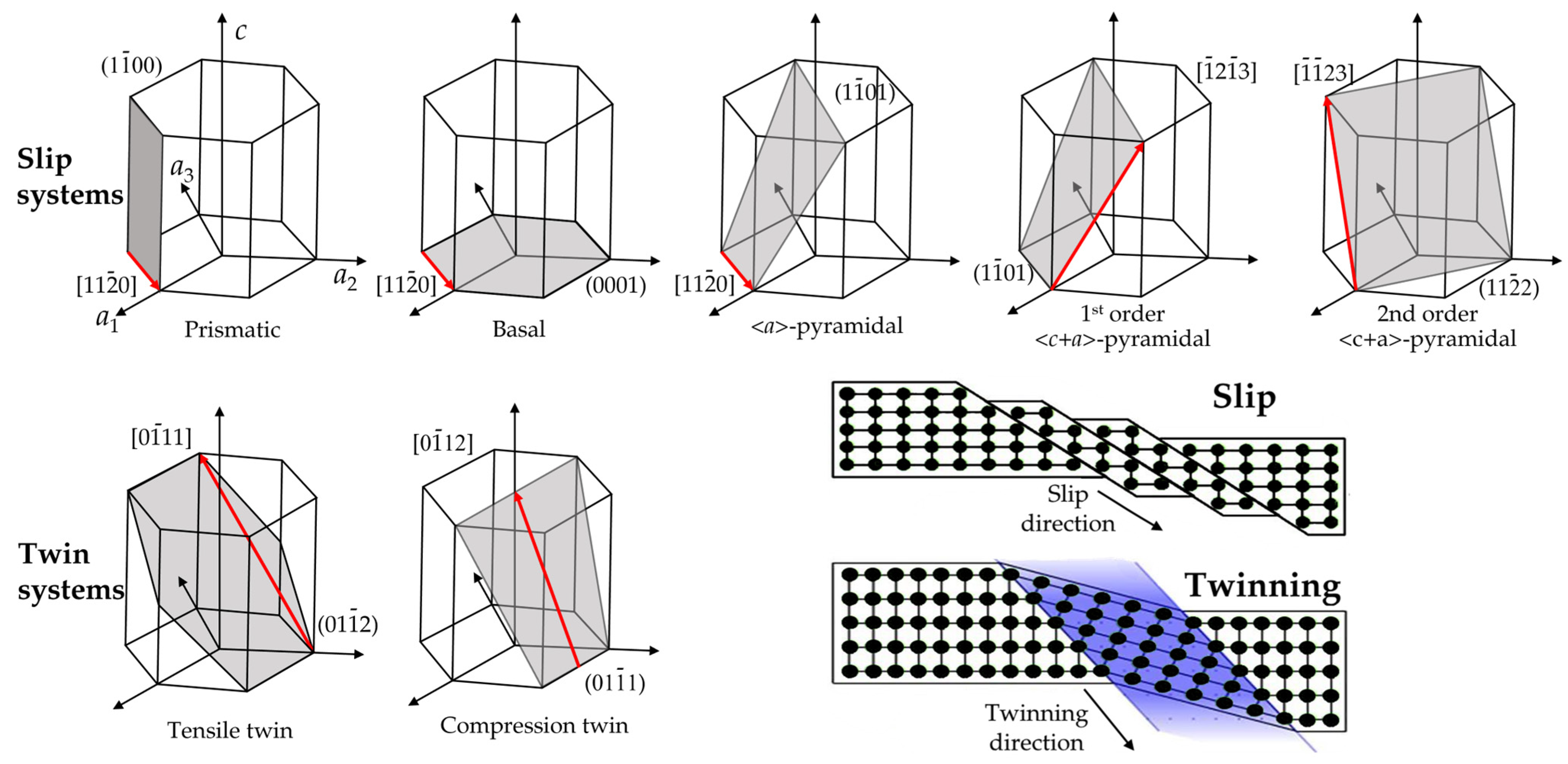

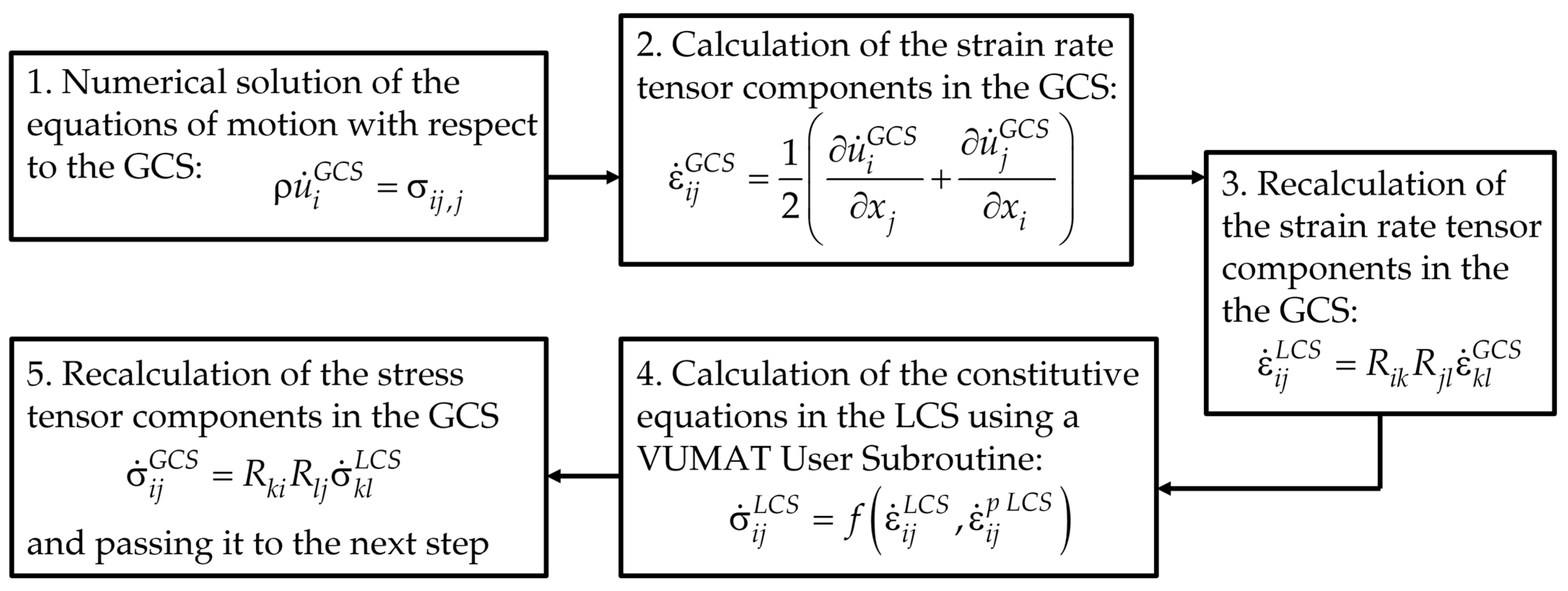
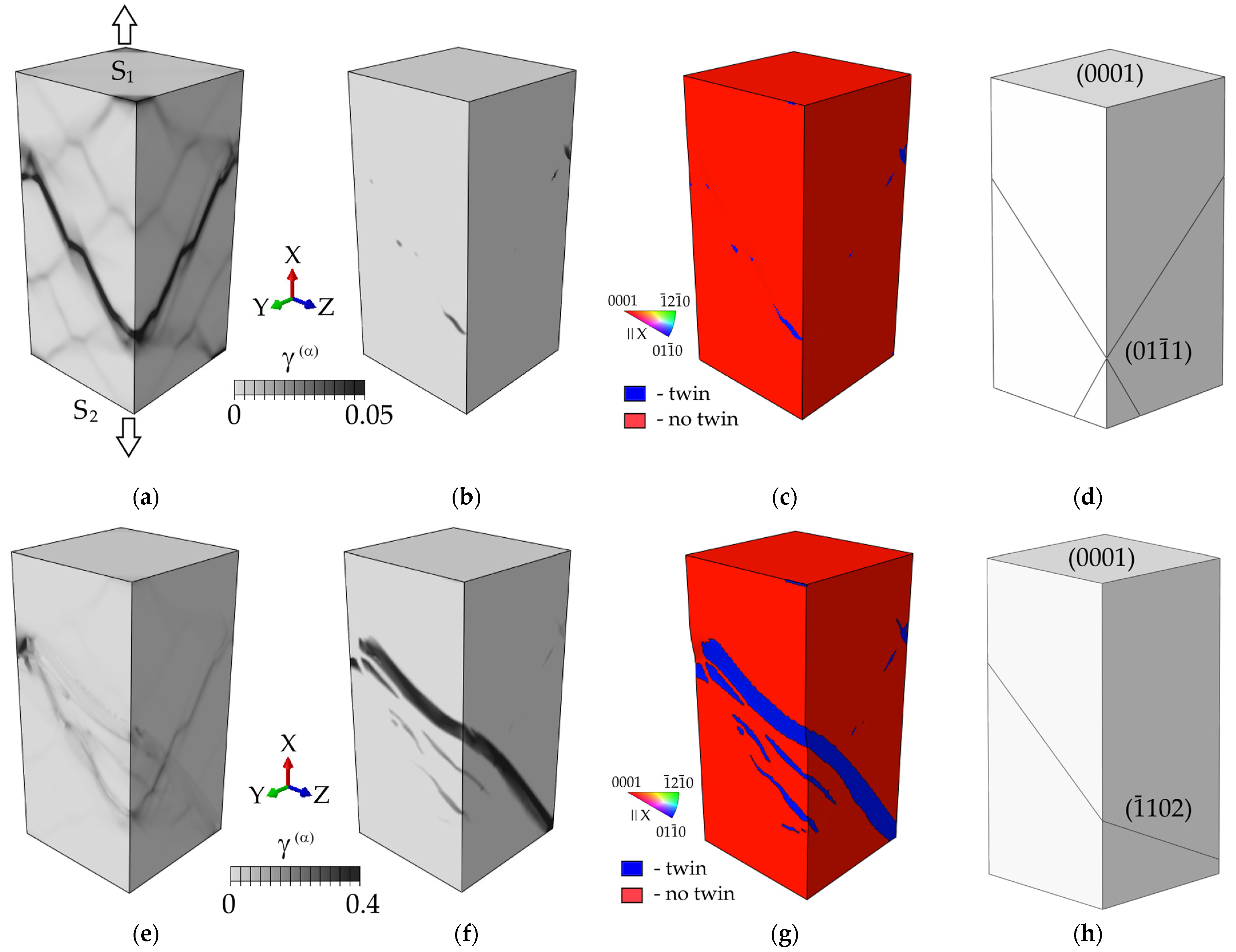

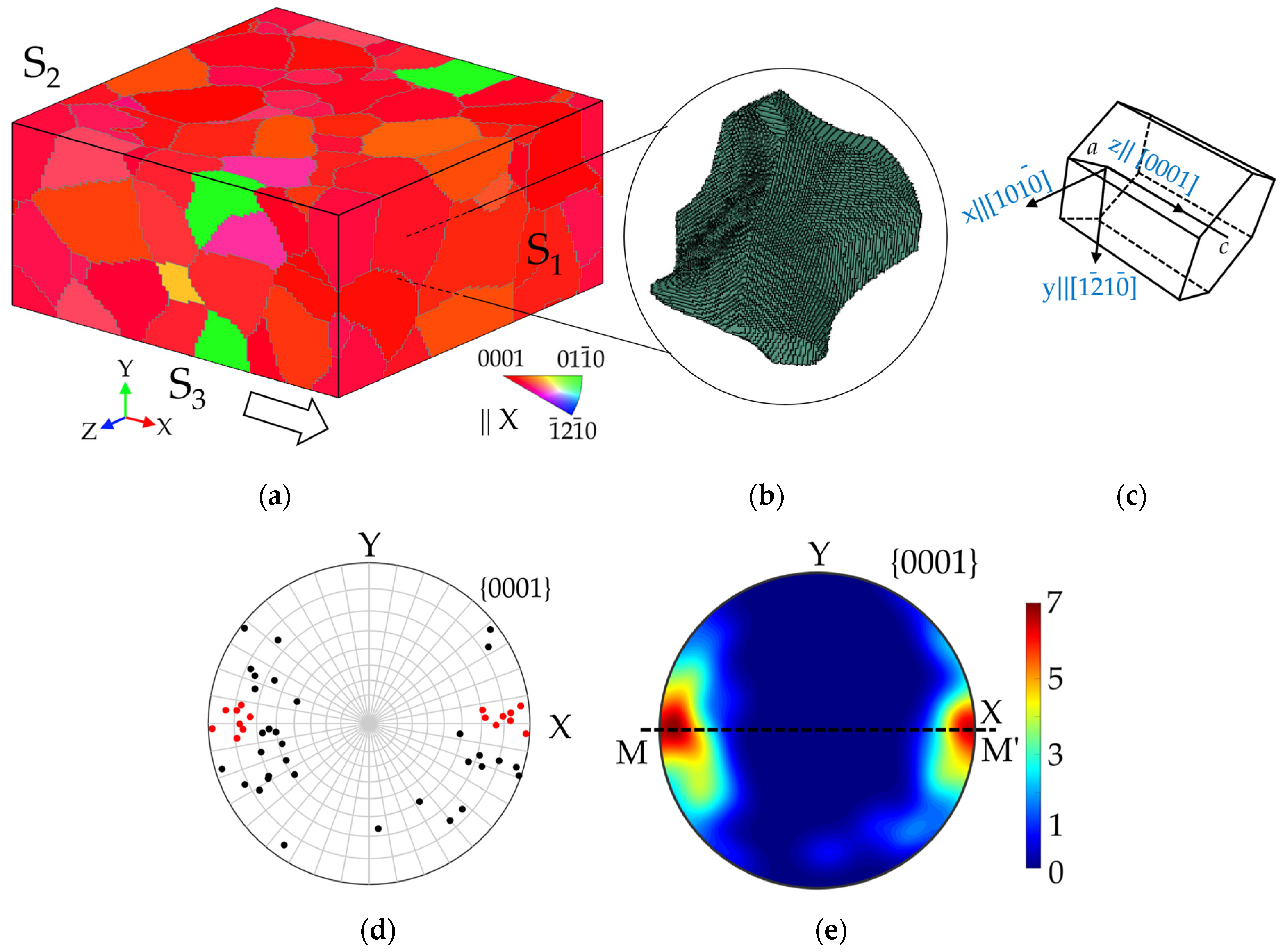

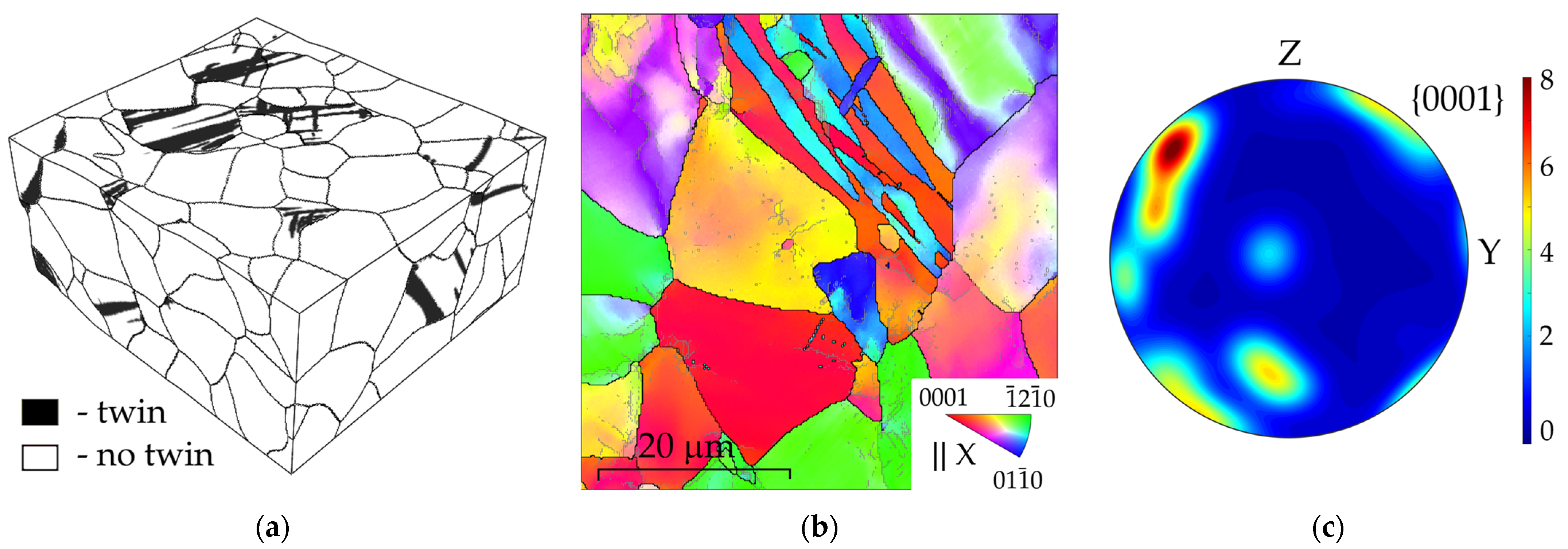
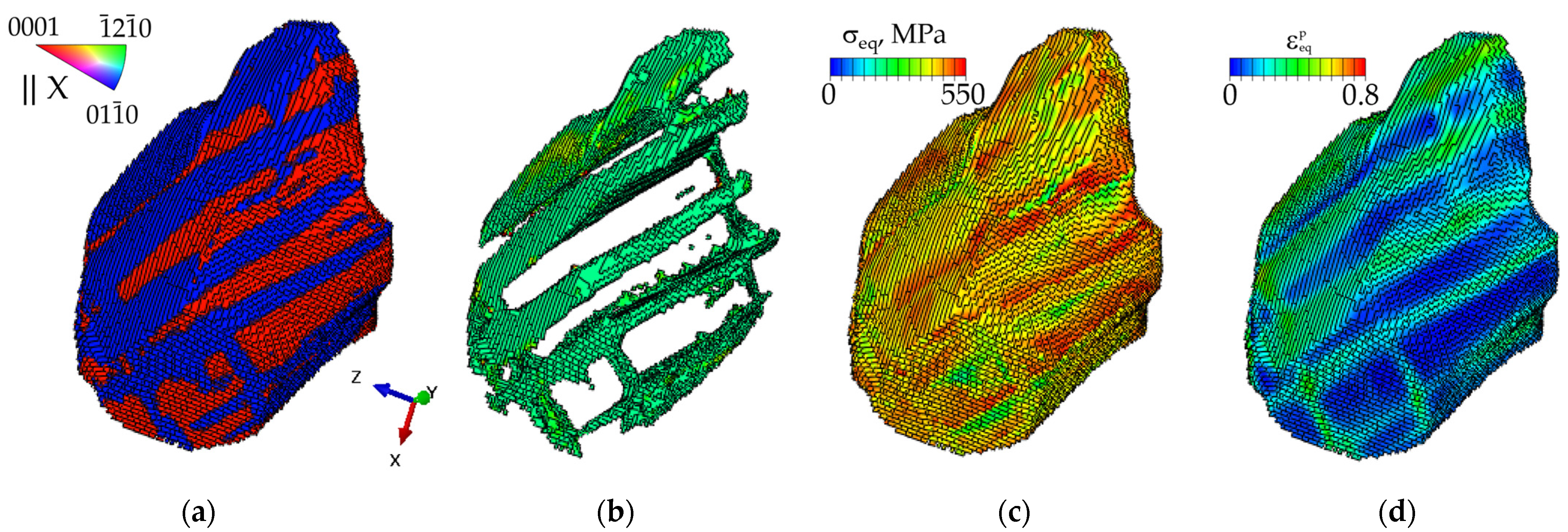
| Slip/Twin Mode | Slip/Twin Plane | Slip/Twin Direction | Number of Systems | , MPa |
|---|---|---|---|---|
| Prismatic | 3 | 70 | ||
| Basal | 3 | 140 | ||
| First-order <c+a>-pyramidal | 12 | 210 | ||
| Tensile twinning | 6 | 145 |
Disclaimer/Publisher’s Note: The statements, opinions and data contained in all publications are solely those of the individual author(s) and contributor(s) and not of MDPI and/or the editor(s). MDPI and/or the editor(s) disclaim responsibility for any injury to people or property resulting from any ideas, methods, instructions or products referred to in the content. |
© 2025 by the authors. Licensee MDPI, Basel, Switzerland. This article is an open access article distributed under the terms and conditions of the Creative Commons Attribution (CC BY) license (https://creativecommons.org/licenses/by/4.0/).
Share and Cite
Emelianova, E.; Pisarev, M.; Balokhonov, R.; Romanova, V. Crystal Plasticity Simulations of Dislocation Slip and Twinning in α-Ti Single and Polycrystals. Metals 2025, 15, 1243. https://doi.org/10.3390/met15111243
Emelianova E, Pisarev M, Balokhonov R, Romanova V. Crystal Plasticity Simulations of Dislocation Slip and Twinning in α-Ti Single and Polycrystals. Metals. 2025; 15(11):1243. https://doi.org/10.3390/met15111243
Chicago/Turabian StyleEmelianova, Evgeniya, Maxim Pisarev, Ruslan Balokhonov, and Varvara Romanova. 2025. "Crystal Plasticity Simulations of Dislocation Slip and Twinning in α-Ti Single and Polycrystals" Metals 15, no. 11: 1243. https://doi.org/10.3390/met15111243
APA StyleEmelianova, E., Pisarev, M., Balokhonov, R., & Romanova, V. (2025). Crystal Plasticity Simulations of Dislocation Slip and Twinning in α-Ti Single and Polycrystals. Metals, 15(11), 1243. https://doi.org/10.3390/met15111243





